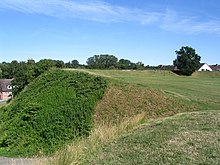Oldenburg Wall Museum
The Oldenburger Wallmuseum (mostly just called "Wallmuseum") in Oldenburg in Holstein shows the history of the Slavs in East Holstein. The museum is supported by the Wallmuseum Oldenburg in Holstein non-profit operating company mbH . The street on which it is located in Oldenburg is named after Karl Wilhelm Struve , who archaeologically researched and documented the ramparts and castles of the Wagrier.
The museum is housed in several historic farm buildings that come from the region and have been faithfully rebuilt on the site. Many archaeological finds from Starigard ("Old Castle"), as the Slavic Oldenburg was called in the early Middle Ages, are on display. A replica of a Slavic village was built as an open-air museum on an artificial island . Events are also held here that bring the everyday life of the Slavs to life. A replica of a Slavic merchant ship from the early Middle Ages found near Eckernförde can also be viewed in its original size.
In May 2014, the open-air area accessible to the public was massively expanded. This now completely encloses the Wallsee with the Slavic island sanctuary. There is also a "hermitage" located in the forest, a small craftsmen's settlement with a blacksmith's shop, rope workshop, woodworker's hut and trader's house, as well as a replica of the Slavic royal court of Starigard / Oldenburg based on the excavation results on the Oldenburger Wall . More craftsmen's houses are grouped around the prince's hall and a scaled-down defensive wall.
The Oldenburger Wall from the Slav period is around 300 m from the museum and can be visited independently of the museum without admission. The fortification, which dates from the 7th century, was later destroyed and renewed by Waldemar II, is considered to be the most important archaeological ground monument in Schleswig-Holstein , along with the Viking settlement of Haithabu and the Danewerk .
Web links
Individual evidence
- ↑ Oliver Narkoinz: The medieval wreck of Schuby beach and the shipbuilding traditions of the southern Baltic Sea. In: Archäologisches Korrespondenzblatt 1998.
Coordinates: 54 ° 17 '47 " N , 10 ° 52' 57" E


